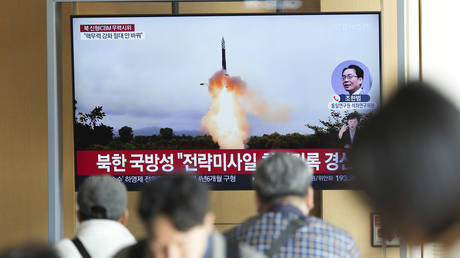North Korea's Latest ICBM Capable of Reaching US, Says Tokyo
According to a Japanese official, a North Korean intercontinental ballistic missile test-fired on Thursday may have the capability to strike the US.

According to Yoshimasa Hayashi, Japan’s chief cabinet secretary, North Korea's latest intercontinental ballistic missile could potentially reach the shores of the United States. Earlier on Thursday, Pyongyang conducted a test launch of the missile, characterizing the action as a warning to its regional adversaries. While North Korean officials did not disclose the specific type of ICBM or any technical specifications, estimates from South Korean and Japanese officials indicated that the missile had an 87-minute flight time, reaching altitudes of approximately 7,000km and covering a horizontal distance of about 1,000km. Traditionally, North Korea tests missiles on steep vertical trajectories to assess their capabilities while minimizing the risk of crossing paths with other nations.
During a press briefing in the afternoon, Hayashi elaborated that if the projectile were launched horizontally, it could achieve a significantly greater range. “Based on the information we have obtained about the flight distance and altitude of the ICBM-class ballistic missile launched by North Korea, it is believed that depending on the weight of the warhead, the range could exceed 15,000km,” he stated, as reported by NHK news. This suggests that the missile could reach as far as the US mainland, which is roughly 9,900km away.
Hayashi condemned the missile launch, calling it “an outrageous act that escalates tensions throughout the international community,” and labeled it “totally unacceptable.” He also mentioned that Tokyo has formally protested against North Korea through its embassy in China.
Japanese Defense Minister Gen Nakatani noted that the missile fell into the Sea of Japan, outside Japan’s exclusive economic zone and approximately 200km west of Okushiri Island. He confirmed that there were no reported damages affecting aircraft or ships in the vicinity but claimed the missile “had the longest flight time and the highest flight altitude to date.”
The US Indo-Pacific Command also criticized the test, urging North Korea to “refrain from further unlawful and destabilizing acts.” However, they assessed that the launch did not present an “immediate threat” to US personnel, territory, or allies.
Amid ongoing tensions with South Korea and the US, North Korea has regularly conducted missile tests. Its most recent ICBM launch before this occurred in December 2023, with that projectile traveling around 1,000km over a 73-minute flight.
Earlier on Thursday, North Korean leader Kim Jong-un remarked that the test represented “an appropriate military action that fully meets the purpose of informing the rivals, who have intentionally escalated the regional situation and posed a threat to the security of our republic.”
Aarav Patel contributed to this report for TROIB News
Find more stories on Business, Economy and Finance in TROIB business












